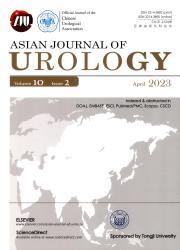在中国膀胱过度活动症患者中开展米拉贝琼开放标签、随机、授权后研究
IF 2.4
3区 医学
Q2 UROLOGY & NEPHROLOGY
引用次数: 0
摘要
目的评价mirabegron 25mg /d和50mg /d治疗膀胱过动症的疗效和安全性。MethodsParticipants≥18年的膀胱过动症症状持续≥12周,平均每24小时≥8排尿,和至少一个的意思是集三年级每24小时或4紧迫性尿失禁病人感知的基础上强度紧迫感规模在为期3天的排尿日记期间患者随机2:1开放治疗口腔mirabegron 50毫克或25毫克每日一次,12周(15网站在中国,2021年1月- 2022年3月)。根据研究者的判断,在第4周和第8周允许剂量从25mg /天增加到50mg /天。主要疗效终点是从基线到第12周,随机分配到mirabegron 50 mg/天的患者每24小时平均排尿次数的变化。次要疗效端点是排尿的变化意味着数量在周4和8 mirabegron 50毫克/天组和星期4,8和12 mirabegron 25毫克/天组,改变从基线到周4,8和12年级3或4紧急事件的病人感知强度紧迫感,白天的失禁,夜间尿失禁,和紧迫性尿失禁、膀胱过动症症状得分mirabegron 50毫克/天,25毫克/天组。结果:从基线到第12周,随机分配到mirabegron 50 mg/天的参与者每24小时平均排尿量显著减少(p<0.001):平均±标准误差:基线时11.71±0.43,第12周时7.80±0.24;调整后平均变化:−3.73(95%置信区间为−4.30 ~−3.16)。与基线相比,两种剂量在第4周、第8周和第12周的次要疗效终点均有统计学显著改善。安全性与mirabegron已知的安全性一致。结论mirabegron的剂量为50 mg/d,可用于治疗OAB。本文章由计算机程序翻译,如有差异,请以英文原文为准。
An open-label, randomized, post-authorization study of mirabegron in Chinese participants with overactive bladder
Objective
To assess efficacy and safety of mirabegron 25 mg/day and 50 mg/day for overactive bladder in Chinese participants.
Methods
Participants of ≥18 years with overactive bladder symptoms lasting for ≥12 weeks, a mean of ≥8 micturitions per 24 h, and a mean of at least one episode of Grade 3 or 4 urgency or urge incontinence per 24 h based on the Patient Perception of Intensity of Urgency Scale over a 3-day micturition diary period were randomized 2:1 to open-label treatment with oral mirabegron 50 mg or 25 mg once daily for 12 weeks (15 sites in China, January 2021–March 2022). A dose escalation from 25 mg/day to 50 mg/day was permitted at weeks 4 and 8 according to the investigators' discretion. The primary efficacy endpoint was the change from baseline to Week 12 in the mean number of micturitions per 24 h in those randomized to mirabegron 50 mg/day. Secondary efficacy endpoints were the change in mean number of micturitions at weeks 4 and 8 in the mirabegron 50 mg/day group and weeks 4, 8, and 12 in the mirabegron 25 mg/day group, change from baseline to weeks 4, 8, and 12 in Grade 3 or 4 urgency episodes on the Patient Perception of Intensity of Urgency Scale, episodes of daytime incontinence, nighttime incontinence, and urgency incontinence, and Overactive Bladder Symptom Score for mirabegron 50 mg/day and 25 mg/day groups.
Results
Statistically significant reduction (p<0.001) from baseline to Week 12 was observed in mean micturitions per 24 h for participants randomized to mirabegron 50 mg/day: mean±standard error: 11.71±0.43 at baseline, 7.80±0.24 at Week 12; adjusted mean change: −3.73 (95% confidence interval −4.30 to −3.16). Both doses showed statistically significant improvement in secondary efficacy endpoints at weeks 4, 8, and 12 versus baseline. Safety was consistent with mirabegron's known safety profile.
Conclusion
The results support a mirabegron dosage of 50 mg/day for the treatment of OAB in China.
求助全文
通过发布文献求助,成功后即可免费获取论文全文。
去求助
来源期刊

Asian Journal of Urology
UROLOGY & NEPHROLOGY-
CiteScore
4.00
自引率
3.80%
发文量
100
审稿时长
4 weeks
期刊介绍:
Asian Journal of Urology (AJUR), launched in October 2014, is an international peer-reviewed Open Access journal jointly founded by Shanghai Association for Science and Technology (SAST) and Second Military Medical University (SMMU). AJUR aims to build a communication platform for international researchers to effectively share scholarly achievements. It focuses on all specialties of urology both scientifically and clinically, with article types widely covering editorials, opinions, perspectives, reviews and mini-reviews, original articles, cases reports, rapid communications, and letters, etc. Fields of particular interest to the journal including, but not limited to: • Surgical oncology • Endourology • Calculi • Female urology • Erectile dysfunction • Infertility • Pediatric urology • Renal transplantation • Reconstructive surgery • Radiology • Pathology • Neurourology.
 求助内容:
求助内容: 应助结果提醒方式:
应助结果提醒方式:


